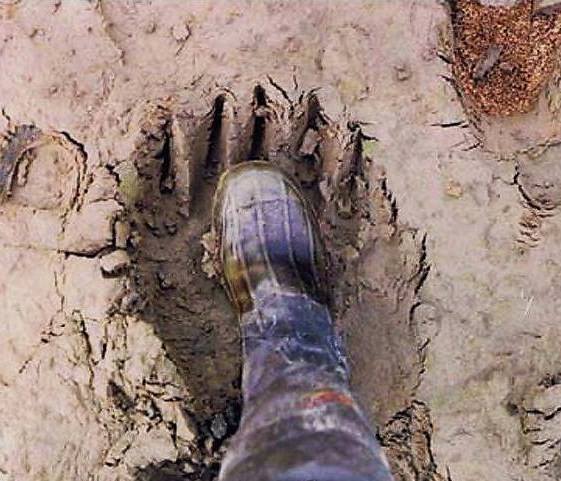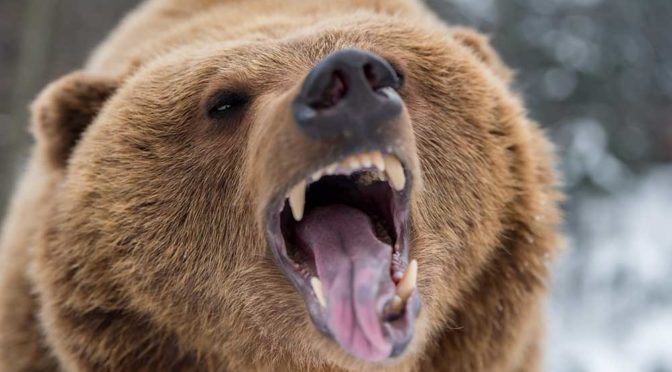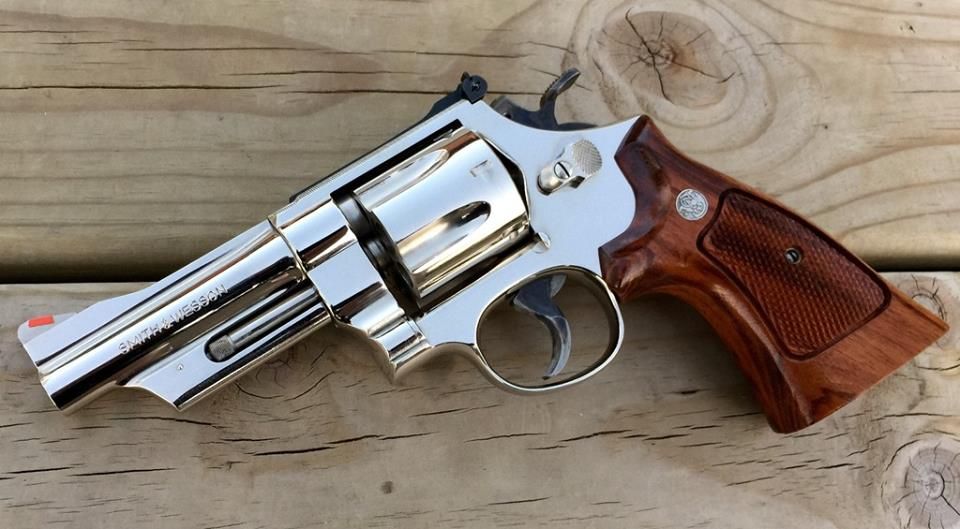 Bears are strong beasts. Grizzly bears are huge, unpredictable, and are predators. Considering that most human bear attacks will end in the bears advantage, how can a human level the odds?
Bears are strong beasts. Grizzly bears are huge, unpredictable, and are predators. Considering that most human bear attacks will end in the bears advantage, how can a human level the odds?
Most bear attacks are a surprise. They happen fast and without warning. Even a trained, experienced professional is challenged to get off a defensive shot quickly. Camp encounters happen in the middle of the night.
Fear is a feeling that people handle differently. Some people panic, others freeze, but some people react and freak out after the attack. What would you do?
Running is a bad choice. A grizzly bear can run 30 mph, 60 yards in 6 seconds, 44 feet per second. How quickly can you get out a can of bear spray, unholster a pistol, ready a shotgun or rifle? Most encounters begin at under 50 yards. The slower runner will lose.
What if the bear makes a bluff charge? If the bear raises their ears and head, they puff up to make themselves look bigger, and move in leaps, with vocalizations, there is a good chance they will be making a Bluff Charge. This means they veer away after a charge. This can be the case from lone male bears and sows, without cubs. They hope to just scare you off. A sow with cubs will protect her babies to the death. If you see cubs, a Bluff Charge is unlikely.
Gun or Bear Spray? Either requires the unit to be drawn, aimed, and a trigger pulled, all while in fear for your life. The spray must hit the bear in the face. This is a relatively small, moving target. A pistol can penetrate the center mass of a bear if it is well aimed.
What pistol is best? Gun owners debate this issue incessantly. Let’s begin low and build up.
9mm is too small and slow. At just 1,000 fps, it lacks power. Even with the right bullets, the bullet lacks power.
45 ACP is also a slow, fat, poor penetrating round unless it uses specific bear ammo and a more powerful powder.
10 mm, with the right bullet is a place to start. Something heavy and designed for bears.
41 mag. / 44 mag. Have good stopping power.
50 cal. This is a huge, heavy weapon. Hard to aim and hold. Huge recoil and more pistol than needed.
357 cal. Is commonly used by guides in Alaska where the biggest bears lurk. The size is manageable, and accuracy is good. A 200-220 Nosler bullet will handle any bear.
Revolver or semi-automatic? An automatic pistol can jam. A revolver will shoot when the trigger is pulled. The semi auto holds more ammo but if you can ‘t do the job with 6 rounds, it won’t matter.
Best Spray to use? Do your homework. You do have choices of types of spray and containers. Fresh is best, not a 20-year-old can.
Where should you carry a pistol/bear spray? Your holster needs to be convenient, but not in the way. A right-handed shooter carries differently than a lefty. Leaving the spray or weapon in your pack is stupid. A belt or shoulder holster is best. The weapon must be free to grab, not under a coat or layers of gear. Practice from the carry position.
Practicing? No matter what Bear protection you prefer, practice is required. If you use bear spray, dedicate a can for practicing. Moving targets are best. The pistol should be drawn, aimed, and shot, quickly and accurately, again at a moving target. Many gun ranges and state agencies offer hands on training courses. Your target is the 9-inch-wide/ paper late sized face of a charging bear’s face.
Knife? Only as a last line of defense. The bade needs to be at least 6 inches long, sharp, and accessible from a sheath on your belt or chest harness. The blade will need to be placed into the bear’s heart or throat. This means that the bear will be on you.
Bow and Arrow? Good luck. A well placed instinctive or aimed arrow will not stop a bear in its tracks. You too will bleed. If you can reload an arrow fast enough for a second shot, you are better than me.
The best way to prevent a Bear attack is to Be Bear Aware at all times. Don’t have a “it will never happen to me attitude.” You will be wrong. Travel/hunt into the wind so you may smell the bear first. Avoid any kills that you encounter. Pay attention to what you see, hear, and feel. Look for scat, tracks, and sign. Make noise if you can. Bear bells, talking, singing, or non-natural sounds will keep bears at bay.
Hunters are in the living room of bears and at a huge risk. Fortunately, they tend to be alert, observant, and not alone. Hunting alone, especially in elk archery season places the hunter at even more risk. Carry protection is essential. Long guns are accurate at longer ranges but getting off a close, moving shot can be a challenge. Bird hunters, using shotguns, are under gunned with bird shot. Camp protection shotguns should have heavy buck shot backed up with slugs.
So, where do you aim to kill a charging Grizzly bear? In 2009 a skilled hunter had to shoot a charging grizzly. He was holding a 44 magnum and hit the bear between the eyes at under 15 yards. The round bounced off. I do not know what load/bullet was used. The bear was stunned and ran off but survived.
Recently a shed hunter was attacked by a Grizzly. He fired several rounds from a 44 mag. Into the bear. The bear still severely injured him but ran off. The bear was found dead, and the shed hunter is recovering in the hospital.
I have never had a personal Grizzly bear attack or make a Bluff Charge. I have talked with others that have. During some archery hunts I have been within 20 yards of grizzly and black bears several times. On one occasion, I had 6 different male grizzly bears that close on the same day, mixed into the herd of elk that I was calling. Black bears have come to my elk call. None of my meat, that I had to leave overnight in the woods, has ever been eaten by bears. There have been some seasons without a bear encounter or sighting.
When I am close to bears, I have made myself look big. This means I stretch my arms with my bow and or gun/pistol. I face the bear but avoid eye contact. I talk “at” the bear in a calm but assertive voice. At the same time, I am backing up and getting prepared for the worst. My goal is to calm the bear and avoid them seeing or hearing me as a threat. Running is not an option. Playing dead may work for some but with a grizzly, you will become food. After an encounter, hunt in a different and safer place.
I carry a 357-mag revolver with the hottest bear load made. I practice drawing and firing. Hopefully I will never have to defend myself from a bear or wolf attack. Bear spray is preferred by some. but I prefer a revolver. Every time I bump into it, on my hip, it reminds me that bears are a threat.
The camp gun is a 12-gauge shotgun with heavy buck shot followed by big slugs. Everyone at camp knows where it is and gets to take a few practice shots. The plug is removed from the shotgun so I can load 5 rounds. I also use Bear proof tactics around camp. The bathroom and cooking/trash areas are away from the sleeping areas. Campers may use pee jugs at night so they can stay in a tent or camp. During the day, their urine is spread around the camp perimeter. I also deployed solar lights around the camp perimeter. Some campers use battery powered electric fences.
There are more Grizzly bears, black bears, and wolves today than before. Conservation groups are protecting inflated populations of Grizzly bears and wolves. The chance of a fatal bear/ wolf encounter is higher now than in the past 150 years. If all your layers of protection and defense have failed to stop the attack, the next step is prayer. Go out fighting. Hopefully every second is the time that your partner/companion needs to assist.
BEARY AWARE!
Montana Grant




